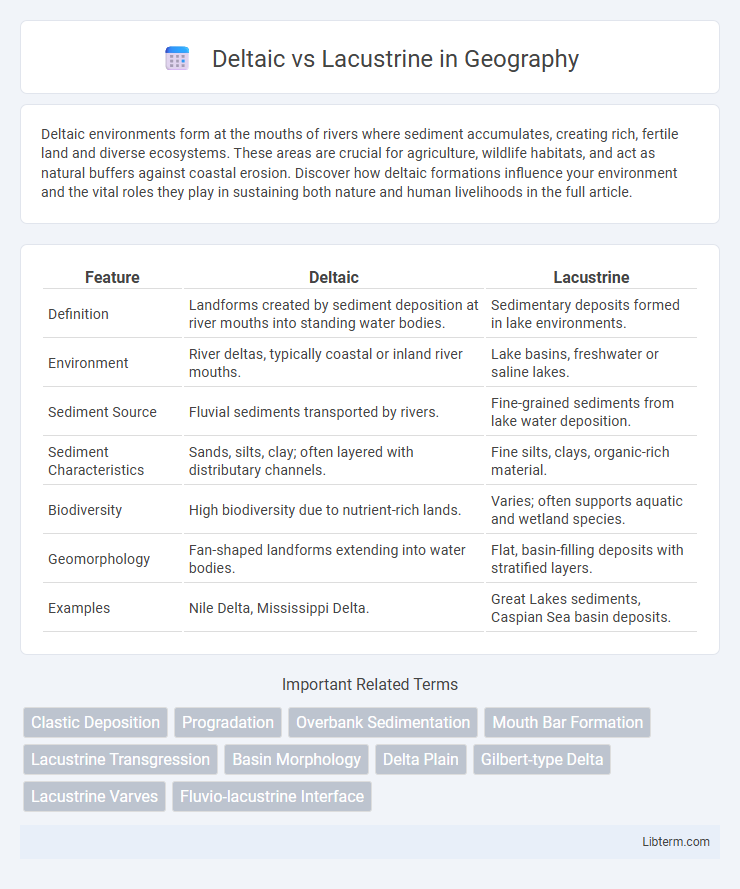Deltaic environments form at the mouths of rivers where sediment accumulates, creating rich, fertile land and diverse ecosystems. These areas are crucial for agriculture, wildlife habitats, and act as natural buffers against coastal erosion. Discover how deltaic formations influence your environment and the vital roles they play in sustaining both nature and human livelihoods in the full article.
Table of Comparison
| Feature | Deltaic | Lacustrine |
|---|---|---|
| Definition | Landforms created by sediment deposition at river mouths into standing water bodies. | Sedimentary deposits formed in lake environments. |
| Environment | River deltas, typically coastal or inland river mouths. | Lake basins, freshwater or saline lakes. |
| Sediment Source | Fluvial sediments transported by rivers. | Fine-grained sediments from lake water deposition. |
| Sediment Characteristics | Sands, silts, clay; often layered with distributary channels. | Fine silts, clays, organic-rich material. |
| Biodiversity | High biodiversity due to nutrient-rich lands. | Varies; often supports aquatic and wetland species. |
| Geomorphology | Fan-shaped landforms extending into water bodies. | Flat, basin-filling deposits with stratified layers. |
| Examples | Nile Delta, Mississippi Delta. | Great Lakes sediments, Caspian Sea basin deposits. |
Introduction to Deltaic and Lacustrine Environments
Deltaic environments form where rivers deposit sediment as they enter standing water bodies like seas or lakes, creating complex patterns of distributary channels and sedimentary layers rich in sand, silt, and clay. Lacustrine environments refer to lake settings characterized by fine-grained sediments such as mud and organic-rich deposits, often preserving delicate fossils and varves indicative of past climatic conditions. These depositional settings are critical for understanding sedimentary processes, reservoir quality in hydrocarbon exploration, and paleoenvironmental reconstructions.
Geological Definitions: Deltaic vs. Lacustrine
Deltaic environments are geological formations where river sediments accumulate at river mouths, forming deltas characterized by distributary channels, delta plains, and prodelta deposits. Lacustrine settings represent sedimentary deposits within lake basins, typically consisting of fine-grained clays, silts, and organic-rich layers formed in quiet water conditions. These distinct depositional environments influence sediment composition, stratification patterns, and fossil content, crucial for interpreting past climatic and hydrological conditions.
Formation Processes of Deltaic Systems
Deltaic systems form through the deposition of sediment carried by rivers as they enter slower-moving or stagnant bodies of water such as seas or oceans, resulting in a complex network of distributary channels and sediment lobes. These formations are influenced by factors like river discharge, sediment supply, wave energy, and tidal processes, shaping the delta morphology over time. The progradation and sediment accumulation create distinct stratigraphic sequences, distinguishing deltaic deposits from lacustrine ones formed in lake environments.
Key Characteristics of Lacustrine Environments
Lacustrine environments are characterized by calm, freshwater conditions that promote fine sediment deposition, such as silts and clays, resulting in well-stratified, laminated sediments. These settings often feature low energy, allowing the preservation of organic material and supporting diverse aquatic ecosystems, including algae and freshwater flora. Lacustrine deposits typically show distinct seasonal varves, reflecting fluctuations in sedimentation rates and biological activity linked to climatic variations.
Sedimentology: Deltaic Deposits vs. Lacustrine Deposits
Deltaic deposits typically consist of coarser-grained sediments such as sand, silt, and clay, displaying complex sedimentary structures formed by fluvial and marine processes in dynamic environments. Lacustrine deposits are characterized by finer-grained sediments, predominantly silts and clays, often exhibiting varves and laminated bedding indicative of low-energy freshwater lake settings. These distinctions in grain size, sedimentary structures, and depositional energy levels reflect differences in hydrodynamics and sediment supply between deltaic and lacustrine sedimentology.
Facies Models in Deltaic and Lacustrine Settings
Facies models in deltaic settings typically exhibit a transition from fluvial channels to distributary mouth bars and prodelta shales, characterized by coarsening-upward sequences and high sediment supply. Lacustrine facies models are dominated by fine-grained, laminated mudstones and carbonates with varve-like seasonal layering reflecting low-energy depositional environments and periodic lake level changes. Deltaic systems show heterogeneity with distributary channel sandstones and interdistributary bays, while lacustrine systems display more uniform, laterally extensive facies controlled by lake basin morphology and chemistry.
Paleogeographic Significance and Examples
Deltaic deposits, formed at river mouths where sediment accumulates rapidly, provide crucial insights into past sea-level changes, sediment supply, and basin subsidence, exemplified by the Mississippi Delta and the Niger Delta systems. Lacustrine environments, characterized by sedimentation in lake basins, record variations in climate, hydrology, and tectonics, as evidenced by the sediments of the Eocene Green River Formation and the Pleistocene Dead Sea Basin. Both depositional settings offer complementary paleogeographic data that help reconstruct ancient landscapes and environmental conditions.
Reservoir Quality: Deltaic versus Lacustrine
Deltaic reservoirs typically exhibit higher permeability and better reservoir quality due to well-sorted sandstones deposited by river-dominated processes, enabling efficient fluid flow. Lacustrine reservoirs often contain finer-grained sediments like shales and siltstones, resulting in lower porosity and permeability that can hinder hydrocarbon extraction. The difference in depositional environments directly influences reservoir heterogeneity, impacting recovery strategies and production efficiency.
Hydrocarbon Potential in Deltaic and Lacustrine Basins
Deltaic basins exhibit significant hydrocarbon potential due to their high organic matter accumulation from rapid sedimentation and nutrient influx in fluvial-dominated environments. Lacustrine basins typically contain fine-grained, organic-rich shales with excellent source rock quality, often generating substantial hydrocarbons under anoxic conditions. The interplay of depositional processes and organic content in both deltaic and lacustrine settings critically influences petroleum system efficiency and reservoir development.
Summary: Comparative Analysis of Deltaic and Lacustrine Systems
Deltaic systems are dynamic environments characterized by sediment deposition at river mouths, forming complex networks of distributary channels and wetlands. Lacustrine systems, defined by lake environments, exhibit fine-grained sediment accumulation with stable, stratified water columns supporting diverse biological communities. Comparative analysis reveals deltaic systems have higher sedimentation rates and nutrient fluxes, while lacustrine systems provide unique paleoenvironmental archives due to their relatively undisturbed sediment layers.
Deltaic Infographic

 libterm.com
libterm.com